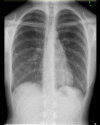Hereditary haemorrhagic telangiectasia and pulmonary arteriovenous malformations
- PMID: 33419752
- PMCID: PMC7799076
- DOI: 10.1136/bcr-2020-238385
Hereditary haemorrhagic telangiectasia and pulmonary arteriovenous malformations
Abstract
Hereditary haemorrhagic telangiectasia (HHT) also known as Osler-Weber-Rendu syndrome is an autosomal dominant disorder affecting 1 in 8000 individuals. The eponym recognises the 19th-century physicians William Osler, Henri Jules Louis Marie Rendu and Frederick Parkes Weber who each independently described the disease. It is characterised by epistaxis, telangiectasia and visceral arteriovenous malformations. Individuals with HHT have been found to have abnormal plasma concentrations of transforming growth factor beta and vascular endothelial growth factor secondary to mutations in ENG, ACVRL1 and MADH4. Pulmonary artery malformations (PAVMs) are abnormal communications between pulmonary arteries and veins and are found in up to 50% of individuals with HHT. The clinical features suggestive of PAVMs are stigmata of right to left shunting such as dyspnoea, hypoxaemia, cyanosis, cerebral embolism and unexplained haemoptysis or haemothorax. The authors present the case of a 33-year-old woman presenting with progressive dyspnoea during the COVID-19 pandemic. She had a typical presentation of HHT with recurrent epistaxis, telangiectasia and pulmonary arteriovenous malformations. Although rare, PAVM should be considered in individuals presenting to the emergency department with dyspnoea and hypoxaemia. Delayed diagnosis can result in fatal embolic and haemorrhagic complications.
Keywords: emergency medicine; respiratory medicine.
© BMJ Publishing Group Limited 2020. No commercial re-use. See rights and permissions. Published by BMJ.
Conflict of interest statement
Competing interests: None declared.
Figures





References
-
- Osler W. On a family form of recurring epistaxis associated with multiple telangiectasis of the skin and mucous membranes. Bull Johns Hopkins Hosp 1901;128:333–7.
-
- Bailey C, Nejad NH, Weiss C. Abstract No. 417 arteriography of pulmonary arteries for pulmonary arteriovenous malformations in hereditary hemorrhagic telangiectasia: national trends, patient characteristics, and outcomes. Journal of Vascular and Interventional Radiology 2020;31:S186–7. 10.1016/j.jvir.2019.12.478 - DOI
-
- Latif M, Sobreira N, Hemmingson T, et al. . Abstract No. 398 pathogenic variants in the Eng, ACVRL1, Smad4, and GDF2 genes and clinical presentations of hereditary hemorrhagic telangiectasia: experience from a single center of HHT excellence. Journal of Vascular and Interventional Radiology 2020;31:S179 10.1016/j.jvir.2019.12.459 - DOI
Publication types
MeSH terms
Substances
LinkOut - more resources
Full Text Sources
Other Literature Sources
Medical
Miscellaneous
